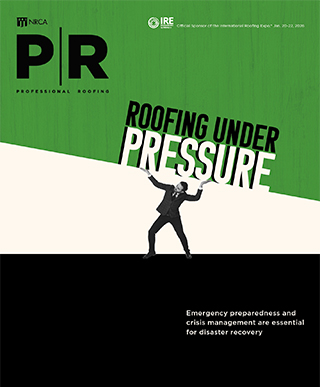
|
The process of constructing buildings and certain building systems and finishes can result in the generation and release of relatively large amounts of moisture. Left unaccounted for and allowed to become entrapped within a building, this moisture can result in premature deterioration of some building systems and materials, including roof systems. Following is a brief discussion of some construction-generated moisture sources and examples of how their effects can be mitigated.
Moisture sources
During construction, large amounts of water are used in the manufacture and installation of certain building materials. For example, a normal-weight structural concrete mix with a water-to-cement ratio of 0.45 contains about 30 gallons of water per cubic yard of concrete. In some instances, additional water is added to ease the transport and placement of concrete. About half of this water will be consumed during the concrete’s hydration and curing process. The remaining water is left to dissipate by evaporation and moisture vapor transport over time.
Similarly, many building construction finish materials contain large amounts of water. Plaster, drywall, drywall compounds, some adhesives and paints contain water that is released during the materials’ curing or drying processes. Water-based products contain and release more water than products with low volatile organic compounds and traditional solvent-based products.
Even some common roofing materials contain large amounts of water. Similar to structural concrete, lightweight insulating concrete contains significant excess water; only a portion of the water the concrete contains at the time of placement is consumed by hydration and curing. Also, water-based primers, adhesives and roof coatings contain significant amounts of water. This water is intended to evaporate during curing and drying; however, some water will be absorbed by the roofing materials the water-based products contact and any excess water is released over time by moisture vapor transport.
Use of temporary heating and enclosures during construction also can result in unintended moisture accumulation. For example, propane combustion, such as that from propane-fired heaters, produces about 1 gallon of liquid water for every gallon of liquid propane consumed.
Construction enclosures intended to contain temporary heat and minimize precipitation entry also can restrict moisture release from the enclosure area. Use of unvented temporary enclosures intended to allow materials to dry or cure can result in moisture transfer from wet materials to other materials within the enclosure via moisture vapor transport.
Roof system components readily can take on construction-generated moisture via moisture vapor transport. An example of this phenomenon is condensation development on the bottom side of a roof membrane or in relatively impermeable insulation materials where no correlating roof system leakage has been identified.
Experience has shown construction-generated moisture issues to be more problematic during cooler months than warm months.
Mitigation
Construction-generated moisture should be recognized and addressed by all parties involved in the construction process, including building owners, designers, general contractors, construction managers and specialty contractors. In this context, accumulation of construction-generated moisture in roof systems should not be considered the responsibility of roofing contractors because the moisture did not likely originate with roofing materials or roof system application methods.
NRCA suggests the following to help mitigate construction-generated moisture:
- Concrete floor and roof deck slabs should be poured before roof system installation. Concrete placement inside enclosed buildings likely will result in moisture accumulation in building envelope assemblies.
- When using low volatile organic compound or water-based products, manufacturers’ recommended minimum application temperatures should be considered. During construction in cooler months, the use of alternative products or components might be necessary. Specific specialty contractors should not have the responsibility of bearing the costs of switching to alternative materials.
- When using temporary heating during construction, the use of nonvented, propane-fired heating equipment should be avoided. The use of electrical-resistance heating units is preferred for temporary heating.
- If temporary enclosures are used below roof assemblies, they should be constructed to allow for venting of accumulating moisture to the building’s exterior.
- If construction-generated moisture inside a building cannot be properly addressed, incorporating a properly designed vapor retarder should be considered for the roof assembly to minimize the potential of interior moisture infiltrating the roof system. If a vapor retarder has not been included in a project’s original design, it should not be the roofing contractor’s responsibility to bear the cost of adding the vapor retarder for this purpose.
Additional information about construction-generated moisture and moisture vapor transport is provided in Chapter 1—Fundamentals of Condensation and Air Leakage Control of the Condensation and Air Leakage Control Section of The NRCA Roofing Manual: Architectural Metal Flashing and Condensation and Air Leakage Control.
MARK S. GRAHAM is NRCA’s vice president of technical services.
This column is part of Research + Tech. Click here to read additional stories from this section.



